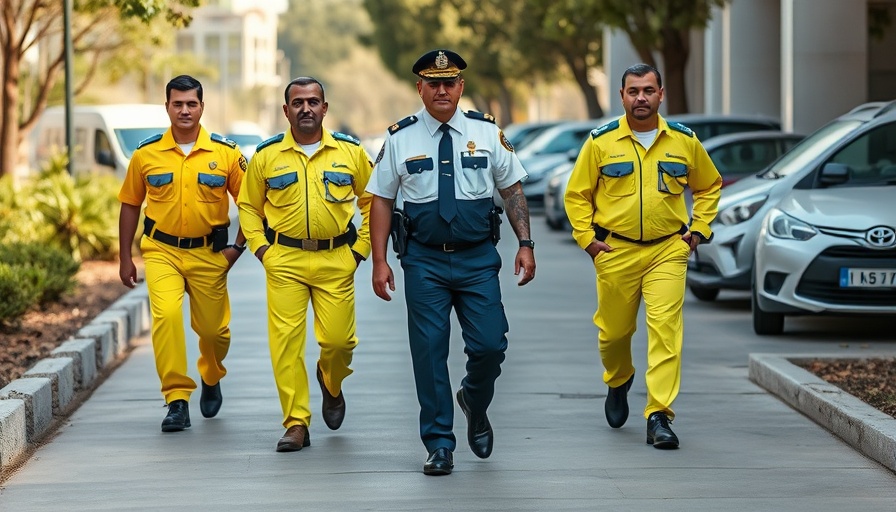
Understanding the Context of the Convoy's Departure
The recent departure of hundreds of volunteers from Tunisia toward Gaza, aptly termed the "Sumud Convoy", encapsulates a broader narrative about international aid efforts amidst political unrest. This initiative, with its name meaning ‘steadfastness’ in Arabic, aims not just to challenge the Israeli blockade of Gaza but also to rally significant public attention towards the dire humanitarian situation faced by many residents in the area. How does this local action resonate with global movements for change? It reflects a growing sentiment of solidarity among those who feel compelled to take a stance against what they perceive as injustices plagued by political conflict.
In 'Land convoy leaves Tunisia for Gaza, in an effort to break Israel's siege', the discussion dives into the complexities of humanitarian aid efforts, prompting a deeper exploration of the implications surrounding this poignant journey.
Highlighting the Motivations Behind the Movement
The participants of the convoy, which encompasses doctors, lawyers, activists, and journalists, are united by a common cause—to alleviate suffering through direct action and awareness-raising. As articulated by organizers from various Tunisian clubs such as the Nabble Club and Star Club, this initiative seeks to empower youth and instill a sense of civic responsibility in responding to international crises. This communal effort signifies a level of engagement that transcends mere awareness, actively challenging oppressive systems and demanding accountability from international actors.
The Political Landscape: Implications of International Pressure
The convoy arrives at a time when Israel faces growing scrutiny regarding its blockade policies. The mounting pressure from humanitarian groups and international bodies amplifies the urgency of the situation in Gaza. The recent interception of a humanitarian boat attempting to deliver aid establishes a poignant reminder of the risks involved in breaking these blockades. Each action, like the Sumud Convoy, serves not only as a pathway for aid but also as a symbolic resistance against perceived tyranny, echoing the challenges of political leadership and its consequences on global humanitarian efforts.
Logistical Challenges: The Road to Gaza
For the Sumud Convoy, the route through Libya and Egypt symbolizes both hope and uncertainty. The convoy is poised at the brink of entering Egypt, but without authorization from Egyptian authorities, the mission's fate remains precarious. This highlights the complex geopolitical landscape—trying to deliver support in an area fraught with political barriers complicates humanitarian efforts. The slow march toward the Rafa border crossing becomes emblematic of the numerous hurdles that aid faces in conflict zones.
Diverse Perspectives: Local Responses to Global Actions
Given the contentious nature of the Israeli-Palestinian conflict, responses to the convoy vary significantly. Meanwhile, domestic and international media portrayals can shape public perception, sometimes amplifying both support and backlash against groups like those participating in the convoy. In an age of rapid information dissemination, understanding the multifaceted responses—from support to skepticism—provides a lens through which we can evaluate civic engagement and activism in today’s world.
The Role of Youth in Activism: Lessons from the Sumud Convoy
At the heart of the Sumud Convoy lies a robust youth engagement component, emphasizing how young people can drive meaningful change. Initiatives stemming from local organizations demonstrate the power of youth mobilization in raising awareness and instigating dialogue about humanitarian crises. This development not only offers insights into contemporary activism but serves as a potential model for future youth-driven initiatives in different parts of the world.
Hope Amidst Challenges: The Future of Humanitarian Aid
The challenges faced by the Sumud Convoy serve as a microcosm of the larger struggles inherent in providing humanitarian aid in conflict zones. Looking ahead, it is imperative to consider innovative solutions, partnerships, and diplomatic efforts that prioritize the safe passage of aid to those in need. Discussions on sustainable aid practices should focus on collaborative frameworks that take into account the complex realities of political unrest.
In essence, the Sumud Convoy is emblematic of a rising commitment to humanitarian causes against formidable political landscapes. As awareness increases, so too does the potential for unity and collaborative action across borders.
With these reflections in mind, we encourage our readers to engage in conversations about humanitarian aid initiatives and consider how they might contribute to or support ongoing efforts in Gaza and beyond. It is in our collective action that we find hope.
 Add Row
Add Row  Add
Add 




Write A Comment